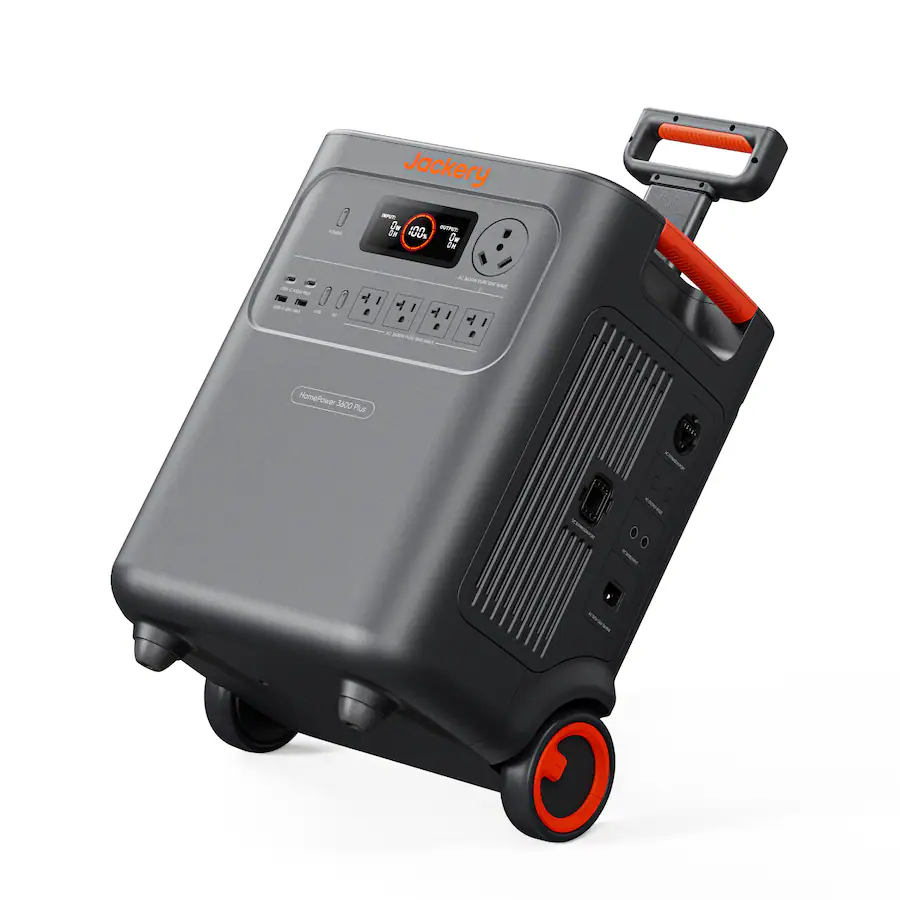

The Jackery HomePower 3600 Plus (HP3600) is only the second power station to carry Jackery’s new “HomePower” name. Unlike their popular Explorer series power stations, which are designed for off-grid adventures and camping, the HomePower lineup was designed for home backup power and RV use (big surprise).
Given the size of the battery and inverter in this unit, we assumed this new 3600 Plus was just Jackery’s answer to the EcoFlow DELTA Pro and the Pecron E3600LFP, finally filling an obvious gap in their product lineup. However, according to Jackery, this is actually the world’s smallest and lightest 3,600Wh power station, and after putting it through our own tests, we have to admit it offers a lot more than we expected.
But does solid performance in a compact and modular package actually earn it the title of Jackery’s best power station yet? Or is this just a rebranded and repackaged Explorer 3000 Pro? Let’s find out.
Before we get into performance, let’s look at what the Jackery HomePower 3600 Power Station is packing under the hood:
{{review-summary}}
We put the HomePower 3600 Plus through our full range of performance tests, checking the efficiency, idle consumption, surge capabilities, and charging performance.
Right away, the Jackery HP 3600 Plus achieved 89% inverter efficiency, which is in line with other top-tier models like the DELTA Pro (88–90%) and Anker F3800 Plus (91%). Since we usually give any power station that has an efficiency rating over 80% a thumbs up, this was a strong start.
The idle consumption measured around 34 watts per hour, which is slightly higher than some competitors, but still perfectly reasonable for a unit this size. For applications like sump pumps and fridges that only cycle occasionally, you’ll still get a few days’ worth of backup power.
And while 34 watts isn’t terrible, we have to mention we felt a bit disappointed given the HomePower 3000 had an idle consumption of just 8 watts—the best we’ve ever seen in any power station.
The inverter performance was impressive. The HomePower 3600 Plus surged up to 5,900W multiple times without tripping, showing that Jackery’s power delivery system can handle demanding appliances. While it didn’t hit the 7,200W surges Jackery advertises, that always felt like it was going to be a stretch.
The UPS (Uninterrupted Power Supply) feature worked up to 1,400W, meaning you can charge it while running mid-size loads without issue. And charging from a standard wall outlet only took about 2.5 hours, and with solar, we reached full battery capacity in around 4 hours using a 1,000W solar panel array under clear conditions.
Overall, the performance numbers were strong, especially considering the compact size and lightweight design of the unit. While it’s not the most powerful home backup system out there, we think it could be one of the most balanced between portability, output power, and practical usability.
Now that we’ve taken a look at the specifications and our own testing, let’s highlight some of the things that stood out to us the most about this portable power station:
At just 77 lbs, the HomePower 3600 Plus is noticeably smaller and lighter than comparable models like the EcoFlow DELTA Pro (99 lbs). Now, 77 lbs might not exactly feel lightweight, but for a unit with a 3,584Wh battery, that’s impressive.
Despite the reduced size, it still delivers 3,600W of continuous output and offers an expandable battery capacity. Again, this is a combination that’s rare at this weight.
Speaking of portability, Jackery nailed it on this unit. The rubber wheels, extendable suitcase-style handle, and side-mounted grab handles make it easy to move. Whether it’s being pulled across a paved garage, on carpet inside a house, or over gravel at a campsite or backyard, you shouldn't run into any issues.
The overall design feels rugged yet sleek, and the orange-and-black Jackery aesthetic still holds up. Whether you use this power station in a workshop or you have it tucked aside in your main living space, it’s not going to look out of place.
While the unit itself outputs 120V, Jackery sells a 240V Hub that lets you connect two HomePower 3600 Plus units together for split-phase power. That means you can run 240V appliances or tie it into a subpanel for limited home backup. Again, this is similar to setups we’ve seen from EcoFlow and Pecron, like the x2 Pecron E3600 + 240V Hub Bundle.
This flexibility is huge for anyone who wants one system that works for both RV power and home backup. When you pair the potential for 240V outputs with that true 30-amp plug and the ability to expand the storage capacity, you start to understand that the “HomePower” label isn’t just marketing fluff.
Speaking of expanding the HomePower 3600 Plus, one of the first things we noticed when we first reviewed the specifications was the ability to expand it up to 21,500Wh by stacking up to six of their Jackery Battery Pack 3600 units.
As a brand, Jackery isn’t really known for focussing on expansion batteries, but they seem to be leaning into the modular expandability angle for this release. Even the Jackery HomePower 3000 didn’t support expansion batteries, which is incredibly surprising for a power station geared towards, well, home power.
According to the Jackery 3600 Plus product page, a fully expanded unit would pack enough backup power to run a fridge for nearly two weeks. Our own testing found closer to 9.5 days, but that’s still a step in the right direction for a brand that usually focuses on camping.
The 89% efficiency and strong surge handling make this a reliable performer for real-world backup power and emergency prep scenarios. It’s also reasonably quiet and feels really well-built, which adds to its overall usability.
You get a nice array of output ports, relatively fast wall charging, and it’s very portable for a unit with its capacity. Basically, it’s just an all-around impressive and versatile power station.
We have to give credit where it’s due, and Jackery’s online usage calculator is actually accurate. It factors in efficiency losses and idle draw, which most brands ignore, or blatantly lie about.
That means you’ll get a realistic estimate of how long your power station will last under different loads. It seems like a simple thing, but we can’t stress enough how rare this is. It’s actually one of the main reasons we feel it's so necessary to test every power station we get our hands on, rather than just trusting the listed specs.
While there was a lot to love about this power station, we did find a few issues that are worth bringing up:
We realize this sounds contradictory given we just praised their power usage calculator, but the Jackery website has been filled with incorrect specifications for years.
At the time of writing this review, the Jackery website lists the HomePower 3600’s AC outlets as running on a 2,400W inverter, while only one plug was labeled as delivering the full 3,600W. The physical unit, product box, and rear label all show it’s a 3,600W power station, so this is likely just a copy-paste error, but it’s not the first time we've come across it.
In this particular case, they’re under-selling the HomePower 3600 Plus, but we’ve run into issues with other power stations where the listed specs overexaggerate what the unit can do. If you’re buying based on information you find on their website, double-check the specs, or just read our reviews and watch our tests.
Jackery is known for adding LED lights on their Explorer models, but they’ve stopped including them on the newer HomePower line. It’s a small thing, but during a power outage or emergency situation, having a built-in light on your power station makes setup and monitoring much easier.
Remember, this is a power station that weighs nearly 80 lbs, so you’re not going to be able to hold a flashlight if you’re carrying this thing up the stairs with both hands. Why not just add a basic light to the front panel?
The suitcase handle doesn’t lock into place properly when it’s fully extended. You can pull it out fully, but it often slides back down unexpectedly. It’s not a dealbreaker, but it’s surprising given Jackery’s usual attention to detail.
With a maximum solar input of 1,000W, it solar charges slower than what you could expect from the units the HomePower 3600 Plus is competing with. For example, the original EcoFlow DELTA Pro can be solar charged at 1,600W, and the newer Anker SOLIX F3800 Plus has an enormous 3,200W solar input.
A 1,000W solar input is going to be fine for most users, but limits your fast off-grid charging potential. For those who have already invested in a high-output solar panel array, it will be hard to look past the Jackery power station’s competition.
This unit hits a sweet spot for RV owners, those living the van-life, and homeowners who want something powerful yet easy to move for home backup and emergency prep.
The 30A RV plug, rubber wheels, and compact design make it great for travel setups or just moving around the house, while the ability to expand to 240V and over 21kWh of battery capacity makes it a legitimate home backup option.
If you’re planning full-house backup or heavy off-grid living, the EcoFlow DELTA Pro 3, DELTA Pro Ultra, or Anker F3800 Plus still offer more flexibility and much higher solar inputs. While the Pecron E3600 or Pecron F3000 would be more budget-friendly alternatives to either of the HomePower power stations.
However, if you want a brand-name portable and user-friendly power station that can still power basic appliances, the Jackery HomePower 3600 Plus delivers.
Jackery’s HomePower 3600 Plus might not reinvent what a power station can be, but it’s easily one of Jackery’s best designs yet. It balances power, portability, and expandability better than a lot of its competitors.
At the current sale price, it becomes an even stronger contender. It’s not perfect, but in terms of performance and portability, this thing punches above its weight.
